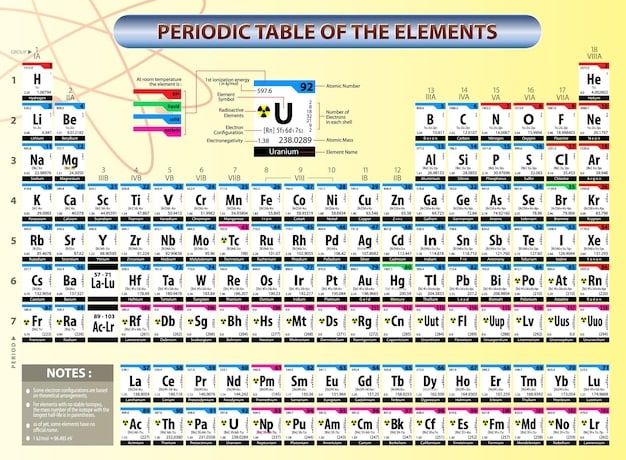Memorize the Periodic Table in 7 Days: Visual Techniques for Chemistry Students

Learn to memorize the periodic table in 7 days using visual memory techniques specifically designed for US chemistry students, enhancing retention and recall.
Struggling to memorize the periodic table for your chemistry class? This guide offers a 7-day plan using visual memory techniques, designed to help US students master the elements with ease and confidence. Learn how to make the seemingly daunting task of memorization not only manageable but also engaging and effective, boosting your understanding and performance in chemistry.
Unlock the Power of Visual Memory for the Periodic Table
Memorizing the periodic table can feel like an uphill battle for many chemistry students. But what if there was a way to transform this daunting task into an engaging and even enjoyable experience? Visual memory techniques offer a powerful alternative to rote learning, allowing you to associate elements with memorable images and stories, making the memorization process much more efficient and long-lasting.
This guide will walk you through a structured 7-day plan to memorize the periodic table using visual memory techniques tailored for US chemistry students. We’ll explore the principles behind visual memory, delve into specific strategies you can use, and provide practical tips to optimize your learning process.
Why Visual Memory Works for Chemistry
The human brain is exceptionally good at remembering images and stories. Visual memory techniques leverage this natural ability by associating abstract information, such as the elements and their properties, with vivid and memorable visuals. This creates stronger neural connections, making it easier to recall the information when you need it.
Think of it like remembering a movie scene versus trying to memorize a list of names. The scene is likely to be far more memorable because it involves visual and emotional elements that engage your brain on multiple levels.
- Enhanced Recall: Visual cues act as triggers, making it easier to retrieve information from your memory.
- Increased Engagement: Visual techniques make learning more interactive and fun, reducing the feeling of boredom and frustration.
- Deeper Understanding: By creating visual associations, you’re forced to think more deeply about the meaning and relationships between the elements.
In essence, visual memory helps you transform the periodic table from a dry list of facts into a vibrant and interconnected world of knowledge.
Mastering the periodic table using visual memory techniques empowers you to excel in chemistry and develop lifelong learning skills.
Day 1: Familiarize Yourself with the Layout and Groups
Before diving into memorization, it’s important to understand the fundamental structure of the periodic table. Day 1 focuses on familiarizing yourself with the groups, periods, and overall organization of the elements.
This initial step lays the groundwork for the visual associations you’ll be creating in the following days. A clear understanding of the layout will make the memorization process much smoother and more effective.
Understanding the Groups and Periods
The periodic table is organized into vertical columns called groups (or families) and horizontal rows called periods. Elements within the same group share similar chemical properties due to having the same number of valence electrons.
Periods, on the other hand, represent the number of electron shells an atom has. As you move across a period, the atomic number and mass generally increase.
- Alkali Metals (Group 1): Highly reactive metals that readily lose one electron.
- Alkaline Earth Metals (Group 2): Reactive metals that readily lose two electrons.
- Halogens (Group 17): Highly reactive nonmetals that readily gain one electron.
- Noble Gases (Group 18): Inert gases with a full outer electron shell.
By understanding these key groupings, you can begin to organize the elements in your mind and recognize patterns.

Taking the time to understand the table’s construction is an investment that pays dividends in the long run. It turns what seems like arbitrary arrangement into sensible organization.
Day 2: Assign Visual Images to the First 20 Elements
Now comes the fun part: assigning visual images to the first 20 elements. This is where your creativity comes into play! The more vivid and unusual your images, the better you’ll remember them.
Don’t be afraid to let your imagination run wild. The key is to create associations that are personally meaningful and memorable for you.
Creating Memorable Visual Associations
Think of each element as a character in a story. What does it look like? What are its characteristics? How does it interact with other elements?
For example:
- Hydrogen (H): Imagine a hydroplane airplane racing across the water.
- Helium (He): Picture a bunch of helium balloons floating into the sky.
- Lithium (Li): Envision a lithium battery powering a small toy car.
The goal is to create a mental movie of each element, complete with sights, sounds, and even smells.
Creating visual images to represent the elements can transform the initially intimidating task of memorization into an exciting opportunity for creativity and imagination.
Day 3: Link Elements Together with Stories
Once you have visual images for the first 20 elements, it’s time to link them together with stories. This technique helps you create a narrative framework that connects the elements in a logical and memorable way.
The story doesn’t have to be complicated. In fact, the simpler and more absurd, the better!
Crafting Engaging Narrative Chains
Use your visual images as stepping stones in your story. Think about how the elements interact with each other in real life (or in your imagination) and weave those interactions into your narrative.
For example, you could create a story about the hydroplane airplane (Hydrogen) being powered by a lithium battery (Lithium) and floating on helium balloons (Helium).
- Story Structure: Begin with a clear starting point, introduce conflicts or challenges, and resolve them in a satisfying way.
- Sensory Details: Engage all your senses in the story. What do you see, hear, smell, taste, and feel?
- Emotional Connection: Infuse your story with humor, excitement, or even a little bit of drama.
By creating a narrative framework, you can transform a collection of isolated images into a cohesive and memorable sequence. This storytelling method leverages your brain’s natural ability to remember patterns and associations.
Day 4: Review and Reinforce the First 20 Elements
Repetition is key to solidifying your memory. Day 4 is dedicated to reviewing and reinforcing your knowledge of the first 20 elements.
Don’t just passively reread your notes. Actively engage with the material by testing yourself and quizzing others.
Active Recall and Spaced Repetition
Active recall involves retrieving information from your memory without looking at your notes. This forces your brain to work harder, strengthening the neural connections associated with the elements.
Spaced repetition involves reviewing the material at increasing intervals. This helps you retain the information over the long term.

- Flashcards: Create flashcards with the element symbol on one side and the name and visual image on the other.
- Quizzes: Take online quizzes or ask a friend to quiz you on the elements.
- Mnemonics: Create memorable phrases or acronyms to help you remember the order of the elements.
Regular review is paramount for the consolidation of memory. Make it a habit to revisit the material to ensure solid learning of each chemical element.
Day 5: Extend Your Visual Memory to Transition Metals
After mastering the first 20 elements, it’s time to tackle the transition metals. These elements, located in the d-block of the periodic table, often have variable valencies and form colorful compounds, making them ideal for visual memorization.
Apply the same techniques you used for the first 20 elements: assign visual images, link them together with stories, and review regularly.
Leveraging Color and Unique Properties
Many transition metals have distinctive colors that can be incorporated into your visual images. For example, copper (Cu) is reddish-brown, chromium (Cr) forms colorful compounds, and gold (Au) is, well, gold!
You can also use the unique properties of each transition metal to create memorable associations. For instance, titanium (Ti) is known for its strength, while zinc (Zn) is used in sunscreen.
Remember, the transition metals have certain elements with colors that are often used to emphasize their unique properties. By using colors, learners increase their chances of recalling and retaining the information effectively.
- Iron (Fe): Picture an iron bridge rusting and turning reddish-brown.
- Nickel (Ni): Imagine a shiny nickel coin.
- Silver (Ag): Envision a shimmering silver necklace.
By leveraging color and unique properties, you can create even more vivid and memorable visual associations for the transition metals.
The colors and distinct properties of the transition metals can serve as mental cues, aiding recall and understanding of these elements’ contributions to compounds and daily applications.
Day 6: Master the Lanthanides and Actinides
The lanthanides and actinides, located at the bottom of the periodic table, are often considered the most challenging elements to memorize. However, with the right visual techniques, you can conquer even these complex elements.
Focus on creating memorable images that highlight the unique properties and uses of these elements.
Utilizing Wordplay and Unusual Associations
Since many lanthanide and actinide names are less familiar, you may need to get creative with your visual associations. Try using wordplay or finding unusual connections to make the elements more memorable.
For example:
- Europium (Eu): Imagine traveling through Europe with a glowing compass.
- Uranium (U): Picture a bright and powerful burst of energy, like a uranium explosion.
- Plutonium (Pu): Envision Pluto, the dwarf planet, glowing with a mysterious energy.
Don’t be afraid to use humor or absurdity in your visual associations. The more outlandish, the better!
Using a personalized approach with wordplay or relevant associations can turn the seemingly difficult task of learning lanthanides and actinides into a rewarding achievement for any chemistry student.
Day 7: Comprehensive Review and Application
Congratulations! You’ve reached the final day of your 7-day memorization challenge. Day 7 is dedicated to a comprehensive review of all the elements you’ve learned and applying your knowledge in practical ways.
Test yourself, quiz others, and look for opportunities to use your newfound knowledge in real-world scenarios.
Testing Yourself and Applying Your Knowledge
Take a comprehensive quiz on the periodic table, covering all the elements you’ve learned. Identify any weak areas and focus your review on those elements.
Look for opportunities to apply your knowledge in everyday life. For example, when you read about a new technology or product, think about the elements that are used in its construction.
- Interactive Games: Play online games that test your knowledge of the periodic table.
- Real-World Connections: Look for elements in everyday objects, such as your phone, your car, or your food.
By actively testing yourself and applying your knowledge, you can solidify your memory and develop a deeper understanding of the periodic table.
By consistently challenging your understanding through tests and linking the elements to real-world scenarios, you can successfully master the periodic table.
| Key Point | Brief Description |
|---|---|
| 🧠 Visual Associations | Link elements to memorable images to aid recall. |
| ✍️ Storytelling | Create stories connecting elements to enhance retention. |
| 🧪 Active Recall | Regularly test yourself to reinforce learned elements. |
| 🎨 Color Coding | Use colors to distinguish and remember transition metals. |
FAQ
▼
Visual memory techniques enhance recall by linking elements to memorable images and stories, making memorization more efficient than rote learning, leading to a deeper understanding of concepts.
▼
Select images that are vivid, personally meaningful, and relate to the element’s properties or name. The more unique and engaging the image, the easier it will be to remember over time.
▼
Regular review and active recall are vital. When you forget, revisit the element, reinforce its image, and add to its narrative to strengthen your memory.
▼
While highly effective for visual learners, this technique can benefit all learners by engaging multiple senses and fostering deeper connections with the material regardless of preference for learning type.
▼
Absolutely! Inventing your own system using wordplay and creative imagery helps make the associations more personal and memorable. Don’t hesitate to use humor!
Conclusion
By following this 7-day plan and incorporating visual memory techniques, you can transform the daunting task of memorizing the periodic table into an engaging and rewarding experience. Remember to be creative, stay consistent, and have fun with the process. With practice and dedication, you’ll not only master the elements but also unlock the power of visual memory for all your learning endeavors.





